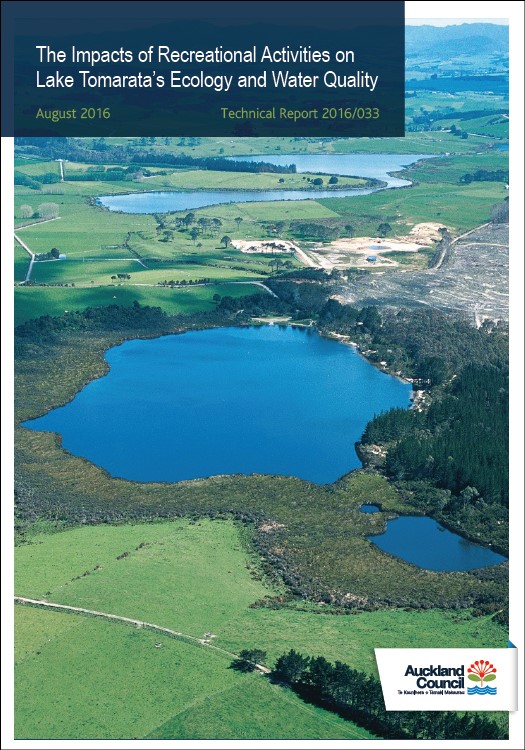The impacts of recreational activities on Lake Tomarata’s ecology and water quality
Author:
Rohan Wells, NIWASource:
Auckland Council Research and Evaluation Unit, RIMUPublication date:
2018Topics:
EnvironmentExecutive summary
The Auckland Council engaged NIWA, the National Institute of Water and Atmospheric Research to review the current and potential impacts of recreational activities on Lake Tomarata’s ecology and water quality, based on previous NIWA aquatic plant surveys, Auckland Council data and the international literature.
This report describes Lake Tomarata’s ecological values and recreational activities, considers the relative impacts of them on Lake Tomarata’s ecology and provides recommendations for mitigation and future work.
Lake Tomarata and its associated 20ha wetland have outstanding ecological values and is listed as a Significant Ecological Area (SEA) in the Auckland Unitary Plan. The lake has an all native submerged vegetation and the wetland provides habitat for a wide range of flora and fauna including two rare plants (one “Nationally Vulnerable” the other “Regionally Critical”), the endemic black mudfish (At Risk – Declining”), bittern (“Nationally Endangered”) and fernbird (“At Risk – Declining”).
The submerged plants have declined alarmingly, from covering virtually the entire lake bed in 1988, to being restricted to a narrow margin now estimated to be less than 10 per cent of the original area. Macrophytes have been declining steadily and are at risk of being lost with the lake flipping into a turbid algal-dominated state. There have also been significant losses of emergent vegetation, particularly kuta.
Recreational activities identified were: shore-based activities including, picnicking, walking, and passive enjoyment; and water-based activities, swimming, kayaking, fishing (trout and coarse), water skiing; jet skiing, wakeboarding and gamebird shooting. The recreational activities are ordered in sequence of increasing impact. All could contribute to what is considered the greatest risk to Lake Tomarata, a fire that could potentially do extensive damage to the wetland’s flora and fauna.
Powered watercraft (particularly wakeboarding boats) create unnaturally high waves that damage marginal wetland vegetation and cause stress to waterbirds and disrupt nesting at the water’s edge. The apparent absence of some bird species (e.g. dabchick and Australian coot) and floating rafts of marginal plants suggest that these impacts are affecting Lake Tomarata’s ecology. Recreational boating is also a potential pathway for the introduction of water weeds and pest fish, which could have a profound impact on the lake.
All recreational activities bring people to the lake and result in people being in close proximity to wildlife with potential for disturbance. Shooting in particular causes disturbance and stress to all birds and protected birds could also be killed or injured.
Turbidity caused by recreational activities is unlikely to be significant and cause impacts in Lake Tomarata, as most of the lake’s vulnerable shores are well buffered by dense wetland vegetation and its beaches are comprised of sand to several metres water depth. Recreational impacts could be avoided or mitigated to varying degrees with a range of measures.
Considering recreational impacts on ecology on the basis of practicality and cost only, the following recommendations should all be given serious consideration:
1. Close the lake at night (to reduce the risk of fire).
2. Prohibit shooting (to reduce disturbance to native birds).
3. Close the lake to powered watercraft (to reduce disturbance to wildlife and wave damage to habitat and nests near the shore).
Note there are also additional considerations that need to be taken into account, such as safety of more intensive use, competing uses and their compatibility, and iwi and community perspectives, that have not been considered within the scope of this report.
This report highlights concerns around deterioration in the lake’s water quality and ecology as recorded in 2004 and 2008 that have not been noted previously. The estimated, greater than 90 per cent loss of macrophyte cover in the lake and changes in the marginal emergent vegetation are a major concern. This information is now eight years old and needs urgent updating. Further work is recommended including:
• Update submerged vegetation data (LakeSPI).
• Conduct a pest fish survey to identify species composition, estimate biomass and extent of impact on Lake Tomarata.
• Re-analyse the water quality information and look for drivers of the ecological change more closely. Identify information gaps where they exist (such as de-oxygenation of bottom waters).
• Consider building a nutrient budget for the lake.
• Consider findings in relation to drivers of deterioration within the lake catchment.
• Identify possible pathways for improving the lake’s ecological status.
Auckland Council technical report, TR2016/033
March 2018
